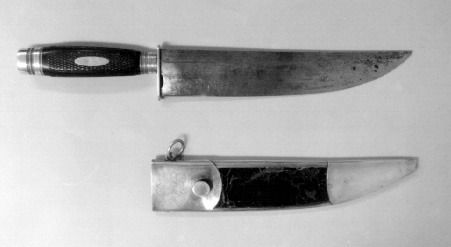This is a question is have been recently dealing with doing the 1830's in Texas.
Some considerations from what I have been able to gather.
The Sheffield England steel industry was able to out-compete most domestic makers in sheer volume such that the most common knifes in these decades were of English make.
The Green River knives were an exception but Green River knife production didn't really take off until the 1840's, AFTER the "pre-1840" thing.
The early decades of the Ninettenth Century were the "big knife" decades, where for most Americans other Americans were the major threat rather than Indians. In this pre-repeating handgun era the big knife became the primary defensive sidearm.
Famous example: the brawls of Jim Bowie, including the sandbar fight that made his reputation (1827??).
Bowie was using essentially a big, domestically produced butcher knife, probably about like this 1830's example....
By the early 1830's Sheffield began flooding the American market with "Bowie Knives", at that time synonymous with "Arkansas Toothpicks" and "Texas Knives".
The Bowie fad REALLY took off after Bowie's heroic end at the Alamo, Brit makers stepping up to meet the demand. At that time most ANY big, fancy knife could be called a "Bowie".
Ironically, it may have been Sheffield that drove the popularity of the classic clip-point "Bowie" design, those being identical or nearly so to what they were selling in Central and South America under other names.
Safest bet for any era? Prob'ly just a regular trade knife looking blade, 5" - 8" long.
JMHO,
Birdwatcher










